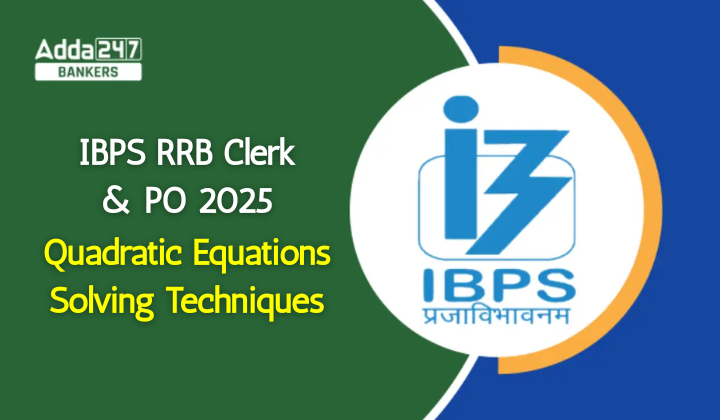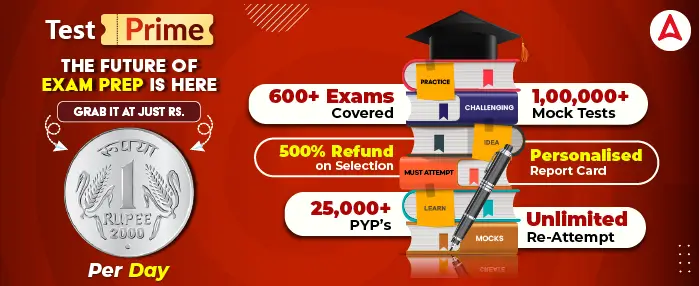Quadratic equations are an important topic in the IBPS RRB Clerk and PO 2025 exams under the Quantitative Aptitude section. These questions usually give you two equations, and you have to find their roots and compare them. Many students find this topic tricky, but with the right methods, it becomes simple. If you learn some basic tricks and practice regularly, you can solve these questions quickly in the exam. This article explains all the easy techniques you should know to solve quadratic equations correctly.
Quadratic Equations Solving Techniques for IBPS RRB Clerk and PO 2025
In the IBPS RRB Clerk and PO 2025 exams, quadratic equation questions are asked to check your basic math and speed. These questions may look difficult at first, but they follow a fixed pattern. If you understand the pattern and use smart solving methods, you can get the answer within seconds. You don’t need long calculations for these questions. Below are the techniques that can help you solve quadratic equations quickly and correctly during the exam.
Factorization Method
This is the most commonly used and time-saving technique. In this method, you break the middle term into two parts such that their product equals the product of the first and last coefficients.
Example:
For the equation x² + 7x + 12 = 0
You need two numbers that multiply to 12 and add up to 7 → 3 and 4
So, the equation becomes: (x + 3)(x + 4) = 0
Roots are x = -3 and x = -4
Using the Quadratic Formula
This method is useful when the equation is not easily factorable. Use this method when the factors are not obvious or the equation is complicated. The formula is:
x = (-b ± √(b² – 4ac)) / 2a
Where a, b, and c are the coefficients from the equation ax² + bx + c = 0
Special Cases and Shortcuts
a. Roots Are Equal
If b² = 4ac, the equation has equal roots.
In such cases, only one value is repeated.
b. No Real Roots
If b² < 4ac, the equation has no real roots.
c. When c = 0
If the constant term is zero, one of the roots will be 0.
Example: x² – 5x = 0 → x(x – 5) = 0 → x = 0 or 5.
Comparing Roots Quickly
After solving both equations, you must compare values of x and y. Use logic instead of writing all comparisons:
- If both roots of x are greater than both roots of y → x > y
- If both roots of x are less than both roots of y → x < y
- If one x is greater and one is smaller → Relation Cannot be Determined.
Quadratic Equations Questions for IBPS RRB Clerk & PO 2025
Directions (1-5): In each of these questions, two equation (I) and (II) are given. You have to solve both the equations and give answer
(a) If x>y
(b) If xy
(c) If x<y
(d) If xy
(e) If x = y or no relation can be established between x and y
Q1. (i) x2 + 13x – 114 = 0
(ii) y3 = 216
Q2. (i) x2-6x+12=4
(ii) y2+4y-10=-13
Q3. (i) 12x2-7x+1=0
(ii) 20y2-9y+1=0
Q4. (i) x2+26x+165=0
(ii) y2+23y+132=0
Q5. (i) x2+x-6=0
(ii) 15y2-11y+2=0
Direction (6 – 10): In each of the following questions two equations are given. Solve these equations and give answer:
(a) if x≥y, i.e., x is greater than or equal to y
(b) if x>y, i.e., x is greater than y
(c) if x≤y, i.e., x is less than or equal to y
(d) if x<y, i.e., x is less than y
(e) x=y or no relation can be established between x and
Q6. (i) x2 + 9 = 73
(ii) y3 = 512
Q7. (i) x2 + 11x + 18 = 0
(ii) y2 + 19y + 90 = 0
Q8. (i). x2-10x+21= 0
(ii). y² –5y+6=0
Q9. (i) 2x2 + x – 1 = 0
(ii) 2y2 + 3y + 1 =0
Q10. (i). 2x² + 13x + 21 = 0
(ii). 2y² + 11y + 14 = 0
| Related Posts | |
| IBPS RRB Clerk Cut Off | IBPS RRB PO Cut Off |
| IBPS RRB Clerk Salary | IBPS RRB PO Salary |
| IBPS RRB PO Syllabus | IBPS RRB Clerk Syllabus |
| IBPS RRB Previous Year Papers | |




 UPSC EPFO Result 2025 Out For EO/AO &...
UPSC EPFO Result 2025 Out For EO/AO &...
 IOCL Non Executive Personnel Recruitment...
IOCL Non Executive Personnel Recruitment...
 Bank of India Credit Officer Recruitment...
Bank of India Credit Officer Recruitment...







